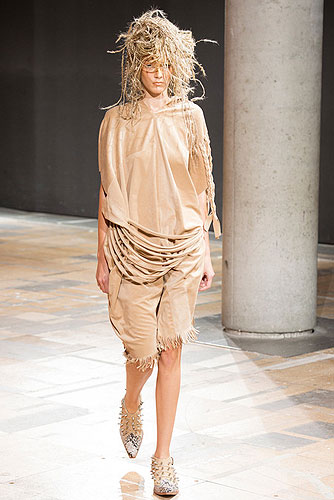




















































Here, wearing extravagant pheasant-feather headdresses, Watanabe's new tribe finished, with the music swiftly cut.
www.junyawatanabe.comParisFashion WeekFashion Brand
Here, wearing extravagant pheasant-feather headdresses, Watanabe's new tribe finished, with the music swiftly cut.
If one designer can make the most vilified, the most ephemeral, the most transitory of things that are normally passed by (while perhaps being scowled at) into full-blown fashion statements that are desirable, monumental, and skilled (leaving you deeply impressed), it is Junya Watanabe. And he did it again in his show today.
Hippies, crusty ravers, anybody who does not wash their hair, claiming, "It will clean itself," the idea of going to Goa, macramé, home crafts, didgeridoos…and so on. This could be seen as a collection and a show incorporating some of this reviewer's most vilified things. And yet that would only be on the surface; in the hands of Junya Watanabe, such horrors became a font of fantastic inspiration from which much else followed.
Take as a starting point the humble T-shirt tassel—that fringed decoration most beloved in the beach T-shirt trade and by the bored home customizer. Watanabe used it heavily, immaculately, and to extravagant effect. While many have been using tight accordion pleating for architectural experimentation this season, Watanabe used fringing. It started in black T-shirting silhouettes, fringed to long, extravagant proportions, some precisely braided and beautifully draped. By the time those looks turned beige and gray, there was a sense of the oddly ancient and classical to the collection. The hair might have started as that of the crusty raver, with messy small braids piled altogether, but the connotations were turning into something else entirely.
This is when Aphex Twin's song "Digeridoo" launched in with complete insistence. It turns out that Richard D. James (Aphex Twin) is not such a fan of the instrument either, and he labored hard to create a similar drone electronically. If anything is a metaphor for what Junya Watanabe does, it's that. In this collection there was a link between past, present, and future; it was the idea of something changing but forever remaining the same that was defined as "Folklore" by Watanabe.
Now the fringing took on the connotations of the American West, and was simultaneously evocative in the Richard Avedon, Ralph Lauren, and Native American sense. The fringing was joined by delicate, horizontal cascading cuts. Suede, or rather suedette, took the place of buckskin, entirely elegant, especially in one open-backed, floor-length coat-dress. Watanabe's excellent denim once again featured, and it led back to one of the new folklore figures encountered earlier. Here, wearing extravagant pheasant-feather headdresses, Watanabe's new tribe finished, with the music swiftly cut. It was a journey through both the playful and profound.